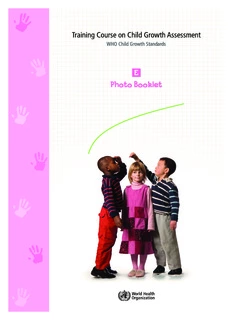
Photo booklet PDF
Preview Photo booklet
(cid:52)(cid:82)(cid:65)(cid:73)(cid:78)(cid:73)(cid:78)(cid:71)(cid:0)(cid:35)(cid:79)(cid:85)(cid:82)(cid:83)(cid:69)(cid:0)(cid:79)(cid:78)(cid:0)(cid:35)(cid:72)(cid:73)(cid:76)(cid:68)(cid:0)(cid:39)(cid:82)(cid:79)(cid:87)(cid:84)(cid:72)(cid:0)(cid:33)(cid:83)(cid:83)(cid:69)(cid:83)(cid:83)(cid:77)(cid:69)(cid:78)(cid:84) (cid:55)(cid:40)(cid:47)(cid:0)(cid:35)(cid:72)(cid:73)(cid:76)(cid:68)(cid:0)(cid:39)(cid:82)(cid:79)(cid:87)(cid:84)(cid:72)(cid:0)(cid:51)(cid:84)(cid:65)(cid:78)(cid:68)(cid:65)(cid:82)(cid:68)(cid:83)(cid:0) Training Course on Child Growth Assessment WHO Child Growth Standards E Photo Booklet Department of Nutrition for Health and Development WHO Library Cataloguing-in-Publication Data WHO child growth standards : training course on child growth assessment. "The project was designed and coordinated by Adelheid W. Onyango and Mercedes de Onis ..."--Acknowledgements. Contents: A. Introduction -- B. Measuring a child's growth -- C. Interpreting growth indicators -- D. Counselling on growth and feeding -- E. Photo booklet -- Answer sheets -- Facilitator guide -- Course director guide -- Boy's growth record -- Girl's growth record -- Job aids. 1.Child development. 2.Growth. 3.Anthropometry - methods. 4.Body weights and measures - standards. 5.Nutrition assessment. 6.Teaching materials. I.Onyango, Adelheid W. II.de Onis, Mercedes. III.World Health Organization. IV.Title: World Health Organization child growth standards. ISBN 92 4 159507 8 (NLM classification: WS 103) ISBN 978 92 4 159507 0 © World Health Organization 2008 All rights reserved. Publications of the World Health Organization can be obtained from WHO Press, World Health Organization, 20 Avenue Appia, 1211 Geneva 27, Switzerland (tel.: +41 22 791 3264; fax: +41 22 791 4857; e-mail: [email protected]). Requests for permission to reproduce or translate WHO publications – whether for sale or for noncommercial distribution – should be addressed to WHO Press, at the above address (fax: +41 22 791 4806; e-mail: [email protected]). The designations employed and the presentation of the material in this publication do not imply the expression of any opinion whatsoever on the part of the World Health Organization concerning the legal status of any country, territory, city or area or of its authorities, or concerning the delimitation of its frontiers or boundaries. Dotted lines on maps represent approximate border lines for which there may not yet be full agreement. The mention of specific companies or of certain manufacturers’ products does not imply that they are endorsed or recommended by the World Health Organization in preference to others of a similar nature that are not mentioned. Errors and omissions excepted, the names of proprietary products are distinguished by initial capital letters. All reasonable precautions have been taken by the World Health Organization to verify the information contained in this publication. However, the published material is being distributed without warranty of any kind, either expressed or implied. The responsibility for the interpretation and use of the material lies with the reader. In no event shall the World Health Organization be liable for damages arising from its use. The named authors alone are responsible for the views expressed in this publication. Printed in China WHO Child Growth Standards Training Course on Child Growth Assessment Acknowledgements This training course has been prepared by the Department of Nutrition, World Health Or- ganization, Geneva. The project was designed and coordinated by Adelheid W. Onyango and Mercedes de Onis who provided the main technical input. Contributions to the technical content by Chessa Lutter (AMRO/PAHO), Cutberto Garza (Boston, MA, USA) and Ilgi Ertem (Ankara, Turkey) are gratefully acknowledged. The field-test version of the materials was reviewed in-depth by staff of the FANTA Project, USAID, and participants in the PAHO regional Training of Trainers workshop in Barbados, May 2006. Version 1, pub- lished in November 2006 was reviewed during Regional workshops in EMRO (Cairo, Feb- ruary 2007), AFRO (Addis Ababa, June 2007), WPRO (Shah Alam, September 2007) and SEARO (Bali, October 2007). The comments and suggestions provided by participants at these workshops have been used to refine the course for this final printing. The course mod- ules were developed and laid out by Patricia Whitesell Shirey and Florence C. Johnson of ACT International, Atlanta, Georgia, USA. With funds from the Bill and Melinda Gates Foundation, the course was field-tested in col- laboration with the Caribbean Program Coordination, PAHO in Barbados, and its first ver- sion further tested and refined with the collaboration of the respective WHO Regional Of- fices (EMRO, AFRO, WPRO and SEARO) and the Country Offices in Ethiopia, Malaysia and Indonesia. Suggested citation: World Health Organization. Training Course on Child Growth Assessment. Geneva, WHO, 2008. Photograph credits: 1. S. Khanum 2. S. Khanum 3. International Centre for Diarrhoeal Disease Research, Bangladesh (ICDDR,B) 4. C. Schofield 5. C. Schofield 6. S. Khanum 7. C. Schofield 8. C. Schofield 9. WHO Multicentre Growth Reference Study 10. P. Shirey 11. M. Caroli 12. WHO Multicentre Growth Reference Study 13. WHO Multicentre Growth Reference Study Study photos 1–8 when instructed in Module B: Measuring a Child’s Growth Three views of marasmus 1. 2. Details about photos 1-8 are provided at the end of the booklet. 3. E: Photo Booklet – 1 Signs of kwashiorkor 5. 4. E: Photo Booklet – 2 7. Oedema of both feet 6. Marasmic kwashiorkor 8. Oedema of both feet E: Photo Booklet – 3 Study photos 9–13 when instructed in Module C: Interpreting Growth Indicators 9. Underweight boy 10. Normal weight boy 1 year, 1 month 3 years, 11 months 70.3 cm, 7.5 kg 109.6 cm, 19.5 kg 11. Obese boy 3 1/2 months, 63 cm, 10 kg E: Photo Booklet – 4
Description: